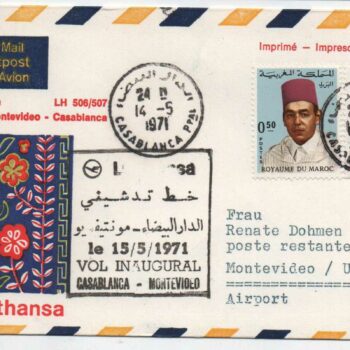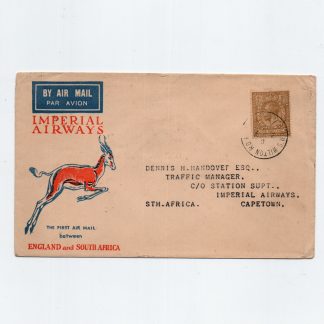
For collectors who find magic in the marriage of stamps and stories, First Flight Covers (FFCs) represent a unique window into both postal and aviation history. These covers—envelopes flown on an aircraft’s inaugural journey along a particular route—are more than just postal artifacts. They’re snapshots of a moment when the sky ceased to be a limit and became a bridge between nations, cities, and people.
What Exactly is a First Flight Cover?
A First Flight Cover is a specially prepared envelope, usually stamped and canceled on the date of the flight, which has traveled on the maiden voyage of airmail service over a specific route. These flights may mark:
- The first airmail delivery between cities or countries.
- The inauguration of a new airline or aircraft type.
- Special commemorative flights, such as anniversaries or landmark aviation events.
Typically, FFCs bear distinctive cachets—designs or stamps printed on the cover to denote the significance of the event. These cachets can range from simple text to elaborate illustrations featuring airplanes, maps, and flight insignia.
Why Are First Flight Covers Important to Philatelists?
- Historical Relevance
FFCs document milestones in aviation and postal history. For instance, a cover from the first transatlantic airmail flight offers a tangible link to the daring pilots and evolving technology of the era. - Geopolitical Significance
Many covers reflect the political landscape of their time. Wartime flights, colonial routes, and the opening of diplomatic relations are all themes found in first flight mail. - Design & Aesthetic Appeal
With striking cachets, period stamps, and often handwritten addresses, these covers are miniature works of art. The convergence of design elements gives each cover a unique character. - Specialization Within Philately
For collectors seeking a niche, FFCs offer a focused area with endless variety—by airline, region, era, or even specific pilots. Some philatelists focus on Pan Am flights, Zeppelin mail, or Concorde inaugural routes.
-
Lufthansa First Flight Cover, Asuncion (Paragua) – Munich, 509, 1971
₹999.00 incl. GST Buy NowAdd to cart -
Lufthansa First Flight Cover, Frankfurt – Spain, LH180/181, 1971
₹999.00 incl. GST Buy NowAdd to cart -
INDIA 1948 BOMBAY LONDON FIRST FLIGHT COVER REGISTERED CAIRO – BOMBAY # FIRST FLIGHT COVER #
₹7,500.00 incl. GST Buy NowAdd to cart -
Bombay -Kuala Lumpur(Single Flight Cover)
₹563.00 incl. GST Buy NowAdd to cart
Collectible Value: What Makes a First Flight Cover Valuable?
While many first flight covers are accessible and affordable, several factors can boost their desirability and value:
- Scarcity: Limited-run covers, especially from early or obscure flights, are more valuable.
- Condition: Like all collectibles, pristine condition with clear cancellations and undamaged envelopes is key.
- Historical Significance: Flights tied to major historical events or famous aviators (like Amelia Earhart or Charles Lindbergh) are highly sought after.
- Autographs: Signed covers—by pilots, designers, or officials—increase collectible worth.
- Provenance: Well-documented or published covers often command higher prices, especially if they’ve appeared in exhibits or notable collections.
Getting Started: Tips for Aspiring Collectors
- Choose a Theme – Focus on a region (e.g., North America), airline (e.g., Lufthansa), or time period (e.g., 1920s-40s).
- Study Catalogs – Resources like the American Air Mail Catalogue help identify and value covers.
- Join Communities – Societies like the American Air Mail Society (AAMS) provide insights, trading opportunities, and exhibitions.
- Buy from Reputable Sources – Auctions, dealer websites, and shows are ideal for finding authentic, quality covers.
- Preserve Properly – Store in acid-free sleeves, away from light and humidity to maintain their condition.
Conclusion
First Flight Covers aren’t just about stamps—they’re about stories. Each one carries the legacy of innovation, bravery, and communication that defined the golden age of aviation. For philatelists, collecting these covers is like curating a museum of the skies—one envelope at a time.
Whether you’re a seasoned collector or just taking off into the world of philately, first flight covers offer a rewarding journey through time, geography, and human ingenuity.
-
Lufthansa First Flight Cover, Frankfurt-Mauritius, LH590/591, 1970
₹999.00 incl. GST Buy NowAdd to cart -
Lufthansa First Flight Cover, Casablanca – Montevideo (Uruguay), LH506/507, 1971
₹999.00 incl. GST Buy NowAdd to cart -
First Airmail berween England and South Africa 1931 Imperial Airways cover
₹2,999.00 incl. GST Buy NowAdd to cart -
Bombay-Doha-Doha-Bombay(Set of 2 Flight Covers)
₹1,069.00 incl. GST Buy NowAdd to cart








